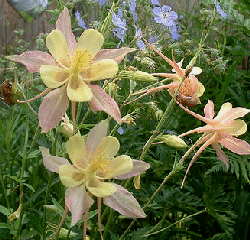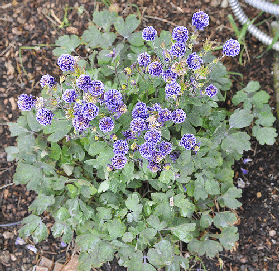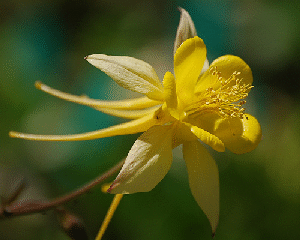Aquilegia Columbine
Aquilegia, delicate and graceful
Aquilegia are graceful flowers, generally with spurs extending from the base of the bloom. The Latin word aquilinum means “eagle like”, the spurs of the bloom suggesting talons of an eagle. Pick the flowers when they are half open for a lovely cut flower. Plant Aquilegia where the exquisitely unusual blooms can be view close up. The plant itself can become somewhat unattractive late in summer, so combine them with low growing greenery so the blooms rise above for a lovely display. Most varieties self seed, are very adaptable and easy to grow in average well drained soil. Columbine will not tolerate heavy, poorly drained soil. To maintain attractive foliage, the soil must be kept uniformly moist. When the foliage does become ragged, cut to the ground. When grown in zones 9 and 10, columbine must have shade to survive. In zone 3, winter protection of heavy mulch is advised. Columbine is often referred to as Granny’s Bonnet.
Columbine are relatively short lived perennials, surviving three to five years. Since they self seed, a supply of new plants each spring will replenish your garden. The bloom season of columbine perfectly fills the gap between spring bulbs and summer perennials.
Aquilegia ‘McKana Hybrids’
Common Name: Columbine
Plant Type: Herbaceous perennial
Height: 24-30”
Spread: 18-24”
Sun/Shade Requirements: Full sun to part shade
Water Requirements: Average, requires weekly water.
Soil Requirements: Average to rich soil that is well loosened and well drained. Will not tolerate heavy clay or wet soil.
Growth Habit: Airy clumps of foliage with blooms on tall stalks.
Bloom Time: Spring to Summer
Bloom Color: A variety of colors, many bi-colored
Bloom Form: A delicate nodding star of outer petals surrounds an inner cup shape petals, often in another color. Long spurs project behind the bloom. A wide range of colors are available.
Foliage: Blue green lacy foliage.
Fragrance: None noted
Pest and Disease Resistance: Deer and rabbit resistant. Sometimes afflicted with leaf miners (cut back to the ground and new growth will begin).
Fertilize: Apply a balanced mix of fertilizer in early spring
Maintenance: Little care is required. Do not divide, mature plants do not like to be disturbed. Propagate by seed (allow to self-seed) and move seedlings as needed.
Other: Attracts hummingbirds and butterflies. Self sowing produces interesting hybrids if other cultivars are close enough to cross pollinate.
Hardiness: Zones 3-8
Aquilegia ‘McKana’ hybrids are the standard by which all other Aquilegia are judged. They are medium to tall, up to 30”, with a wide range of colors available. Colors tend to be pastel but some are bright, all are certainly colorful. The blooms have long spurs, are nodding, and are often bi-colored. They typically bloom in April and May. The foliage is gray green with a clump forming habit.
‘McKana hybrids’ require little care. Foliage can be left to overwinter. In spring only remove the dead leaves. Do not divide, as mature plants do not like to be disturbed. Since Aquilegia self-seeds, allow propagation by not deadheading late blooms and move the seedlings as necessary. The plants are short lived, only 3 to 4 years, allowing to self seed will replace expired plants Deadhead the early spent blooms to prevent self seeding and encourage additional blooming. Withering or damaged foliage can be cut back to new growth to refresh the plant.
Light shade will prolong blooming period. Cut flowers can last up to 2 weeks. Perfect choice for an entry garden.
‘Mckana Giant Hybrid’ is essentially the same, but the blooms are extra large. The plant may reach up to 5 feet tall with a 3 foot spread. Bloom period is May through June. The cut flower only lasts a few days
Aquilegia vulgaris ‘Winky Series’
Common Name: Columbine
Plant Type: Herbaceous perennial
Height: 14-20”
Spread: 12-18”
Sun/Shade Requirements: Full sun to part shade
Water Requirements: Average, water deeply and allow to begin to dry before next watering.
Soil Requirements: Average to rich soil that is well loosened and well drained. Will not tolerate heavy clay or wet soil.
Growth Habit: Compact mounded foliage with blooms held on medium stalks.
Bloom Time: April to May
Bloom Color: Bi-color blooms in blue and white, red and white, purple and white or rose pink and white.
Bloom Form: Upward facing bi-color blooms with short spurs
Foliage: Medium green, three parted lacy leaves.
Fragrance: None noted
Pest and Disease Resistanc e: Deer resistant. Occasiona lly bothered by aphids, leaf miners or spider mites.
Fertilize: Apply a balanced mix of fertilizer in early spring. Additional fertilizer may be applied every 4 weeks to keep the foliage fresh, but do NOT over fertilize.
Maintenance: Little care is required. Do not divide, mature plants do not like to be disturbed. Propogate by seed (allow to self-seed) and move seedlings as needed.
Other: Attracts hummingbirds and butterflies. Self sowing produces interesting hybrids if other cultivars are close enough to cross pollinate.
Hardiness: Zone 4-8
Aquilegia vulgaris ‘Winky Series’ is a dwarf to semi-dwarf series that are terrific for container gardening and front of the border. They are generally about 10-12” in a container and may get up to 18” when used in the landscape. This award winning series produces upward facing blooms on sturdy stems. Cheery bi-color blooms are produced in abundance
‘Winky Double’ produces upward facing short spurred blooms with frilly petals edged in white and yellow gold stamens. Bi-color blooms are available in rose and white, blue and white, red and white; and white.
Aquilegia chrysantha ‘Yellow Queen’
Common Name: Columbine
Plant Type: Herbaceous perennial
Height: 2-3 feet
Spread: 2-3 feet
Sun/Shade Requirements: Full sun to part shade
Water Requirements: Average requirements, keep soil uniformly moist
Soil Requirements: Average to rich soil that is well loosened and well drained. Will not tolerate heavy clay or wet soil.
Growth Habit: Bushy, clump forming with blooms held on tall stalks.
Bloom Time: April through May
Bloom Color: Lemon yellow
Bloom Form: Nodding blooms with long spurs
Foliage: Gray green with a bluish tinge. Three lobed lacy leaves.
Fragrance: Sweet scent
Pest and Disease Resistance: Deer and rabbit resistant. Occasionally bothered by aphids, leaf miners or spider mites.
Fertilize: Apply a balanced mix of fertilizer in early spring. Additional fertilizer may be applied every 4 weeks to keep the foliage fresh, but do NOT over fertilize.
Maintenance: Little care is required. Mature plants prefer not to be disturbed, but if necessary divide in early spring.
Other: Attracts butterflies and hummingbirds
Hardiness: Zone 3-9
‘Yellow Queen’ has very long outward curving spurs behind sunny yellow flowers on long stems. The coloring is superior to most yellow columbines, being solid and bright. ‘Yellow Queen’ is an exceptional cultivar with large very showy blooms and one of the longest bloom period of the Columbines. It is also fragrant and a truly wonderful cut flower. Stunning when planted with blue or purple perennials.
Aquilegia ‘Biedermeier
Common Name: Columbine
Plant Type: Herbaceous perennial
Height: 8-18”
Spread: 8-12”
Sun/Shade Requirements: Full sun to part shade
Water Requirements: Average, water deeply and allow to begin to dry before next watering.
Soil Requirements: Average to rich soil that is well loosened and well drained. Will not tolerate heavy clay or wet soil.
Growth Habit: Mounding with blooms on short to medium stems
Bloom Time: May through June
Bloom Color: Pink, white, blue or red. Often offered as a pastel mix.
Bloom Form: Upward facing flowers with long spurs. A star of outer petals surrounds an inner cup with yellow centers.
Foliage: Medium bluish green, three parted lacy leaves.
Fragrance: None noted
Pest and Disease Resistance: Deer resistant. Occasionally bothered by aphids, leaf miners or spider mites.
Fertilize: Apply a balanced mix of fertilizer in early spring. Additional fertilizer may be applied every 4 weeks to keep the foliage fresh, but do NOT over fertilize.
Maintenance: Little care is required. Do not divide, mature plants do not like to be disturbed. Propagate by seed (allow to self-seed) and move seedlings as needed.
Other: Attracts hummingbirds and butterflies. Self sowing produces interesting hybrids if other cultivars are close enough to cross pollinate.
Hardiness: Zones 3-9, zone 2 with protection.
‘Biedermeier’ is the lowest growing Aquilegia, they are excellent in a container, entry garden, rock garden or front of the border.. It blooms early with a profusion of flowers, dense clusters of flowers are produced. The blooms tend to face more forward rather than upright or nodding. ‘Biedermeier’ self seeds quite readily.
‘Biedermeier’ columbine will tolerate a bit drier soil conditions than most columbine, and is more cold hardy. It easily withstands zone 3 winters and will probably survive in zone 2 if heavily mulched. It does not seem as attractive to hummingbirds and butterflies as most columbine.
Aquilegia canadensis
Common Name: Eastern Red Columbine, Wild Red Columbine
Plant Type: Herbaceous perennial
Height: 2-3 feet
Spread: 1-2 feet
Sun/Shade Requirements: Full sun to part shade
Water Requirements: Average, water deeply and allow to begin to dry before next watering.
Soil Requirements: Average to rich soil that is well loosened and well drained. Will not tolerate heavy clay or wet soil.
Growth Habit: Upright, branching
Bloom Time: April through May
Bloom Color: Pink, red and yellow
Bloom Form: 1-2” blooms formed by star shaped outer petals and inner petals in a cup shape. There are 5 distinctive red spurs and yellow centers of many stamens of varying lengths.
Foliage: Deep green, three parted lacy leaves.
Fragrance: None noted
Pest and Disease Resistance: Deer resistant. Occasionally bothered by aphids, leaf miners or spider mites.
Fertilize: Apply a balanced mix of fertilizer in early spring. Additional fertilizer may be applied every 4 weeks to keep the foliage fresh, but do NOT over fertilize.
Maintenance: Little care is required. Do not divide, mature plants do not like to be disturbed. Propagate by seed (allow to self-seed) and move seedlings as needed.
Other: Attracts hummingbirds and butterflies. Self sowing produces interesting hybrids if other cultivars are close enough to cross pollinate.
Hardiness: Zones 3-8
Aquilegia canadensis columbine produces striking red blooms streaked with yellow. Like most columbine, the blooms nod downward. Canadensis is native to much of the eastern half of the US, and is referred to often as Wild Red Columbine. The foliage remains fresh longer than other columbine, especially if the soil is kept moist. A wide range of soil types are tolerated as well as occasional dry spells.
Canadensis is an excellent cultivar for naturalizing or in a native plant garden, cottage garden, entry garden or perennial border. Bloom period is generally April through May, but has been known to bloom much longer into the summer in the right conditions.
Aquilegia vulgaris ‘Lime Sorbet’
Common Name: Columbine
Plant Type: Herbaceous perennial
Height: 39”
Spread: 36”
Sun/Shade Requirements: Full sun to part shade
Water Requirements: Average, water deeply and allow to begin to dry before next watering.
Soil Requirements: Average to rich soil that is well loosened and well drained. Will not tolerate heavy clay or wet soil.
Growth Habit: Compact and neat mound with blooms on tall stems.
Bloom Time: May through June
Bloom Color: Soft lime green to white
Bloom Form: Fully double blooms of long slender petals, nodding downward and spur-less.
Foliage: Blue green, three parted lacy leaves.
Fragrance: None noted
Pest and Disease Resistance: Deer resistant. Occasionally bothered by aphids, leaf miners or spider mites.
Fertilize: Apply a balanced mix of fertilizer in early spring. Additional fertilizer may be applied every 4 weeks to keep the foliage fresh, but do NOT over fertilize.
Maintenance: Little care is required. Do not divide, mature plants do not like to be disturbed. Propagate by seed (allow to self-seed) and move seedlings as needed.
Other: Attracts hummingbirds and butterflies. Self sowing produces interesting hybrids if other cultivars are close enough to cross pollinate.
Hardiness: Zones 3-8
‘Lime Sorbet’ is a spur-less cultivar with double blooms. A. vulgaris are generally short spurred or spur-less. The spurs are an extension of the petal that is tubular and nectar filled at the end knob. These tubes are adapted to long tongued feeders such the hummingbird, so a spur-less variety may not be quite as attractive to hummingbirds.
One of the newer varieties of Columbine, ‘Lime Sorbet’ has large striking double blooms of a lime green that softens and fades to white. The blooms nod downward above a neat clump of foliage.
The color change of the bloom makes the cut flower even more interesting in a vase. ‘Lime Sorbet’ is wonderful as a specimen plant or planted in masse, as well as in the perennial garden.
Aquilegia vulgaris var. stellata ‘Blue Barlow’
Common Name: Columbine
Plant Type: Herbaceous perennial
Height: 24-36”
Spread: 14-18”
Sun/Shade Requirements: Part sun to part shade
Water Requirements: Average, water deeply and allow to begin to dry before next watering.
Soil Requirements: Average to rich soil that is well loosened and well drained. Will not tolerate heavy clay or wet soil.
Growth Habit: Clump forming with blooms on long stems
Bloom Time: May and June
Bloom Color: Deep violet blue
Bloom Form: Fully double spur-less blooms with long narrow petals.
Foliage: Gray green, three deeply parted lacy leaves.
Fragrance: None noted
Pest and Disease Resistance: Deer resistant. Occasionally bothered by aphids, leaf miners or spider mites.
Fertilize: Apply a balanced mix of fertilizer in early spring. Additional fertilizer may be applied every 4 weeks to keep the foliage fresh, but do NOT over fertilize.
Maintenance: Little care is required. Do not divide, mature plants do not like to be disturbed. Propagate by seed (allow to self-seed) and move seedlings as needed.
Other: Attracts hummingbirds and butterflies. Self sowing produces interesting hybrids if other cultivars are close enough to cross pollinate.
Hardiness: Zones 3-8
‘Blue Barlow’ produces fully double deep violet blue blooms without spurs. The blooms are large and resemble a dahlia. These are especially nice flowers for cutting and last long in a vase. Cutting and deadheading this perennial will prolong the bloom period. ‘Blue Barlow’ prefers a little shade, particularly in hot climates where afternoon shade will benefit the plant. Full sun is still appropriate in cold regions. Silver foliaged plants are an excellent companion to the deep blue blooms.
There are several varieties in the Barlow series that are double and spur-less, including ‘Barlow Red’, ‘Black Barlow’, ‘Barlow Bordeaux’, ‘Barlow Christa’, ‘Barlow Rose’ and others. The Barlow series plants are incredible in full bloom, excellent for cut flowers, perennial gardens, entry gardens or as a specimen plant.
Aquilegia vulgaris ‘Nora Barlow’
Common Name: Columbine
Plant Type: Herbaceous perennial
Height: 24-28”
Spread: 12-18”
Sun/Shade Requirements: Full sun to part shade
Water Requirements: Average, water deeply and allow soil to begin to dry.
Soil Requirements: Average to rich soil that is well loosened and well drained. Will not tolerate heavy clay or wet soil.
Growth Habit: Clump forming with blooms held on long stems.
Bloom Time: May through June
Bloom Color: Rose pink to maroon with soft white to light green edges
Bloom Form: Fully double spur-less blooms on long stems, downward nodding.
Foliage: Medium green, three parted lacy leaves.
Fragrance: None noted
Pest and Disease Resistance: Deer resistant. Occasionally bothered by aphids, leaf miners or spider mites.
Fertilize: Apply a balanced mix of fertilizer in early spring. Additional fertilizer may be applied every 4 weeks to keep the foliage fresh, but do NOT over fertilize.
Maintenance: Little care is required. Do not divide, mature plants do not like to be disturbed. Propagate by seed (allow to self-seed) and move seedlings as needed.
Other: Attracts hummingbirds and butterflies. Self sowing produces interesting hybrids if other cultivars are close enough to cross pollinate.
Hardiness: Zones 3-9
‘Nora Barlow’ produces fully double rose pink to maroon blooms with white to light green margins, without spurs. The blooms are large and resemble a dahlia. These are especially nice flowers for cutting and last long in a vase. Cutting and deadheading this perennial will prolong the bloom period. ‘Nora Barlow’ prefers a little shade, particularly in hot climates where afternoon shade will benefit the plant. Full sun is still appropriate in cold regions.
There are several varieties in the Barlow series that are double and spur-less, including ‘Barlow Red’, ‘Black Barlow’, ‘Barlow Bordeaux’, ‘Barlow Christa’, ‘Barlow Rose’ and others. The Barlow series plants are incredible in full bloom, excellent for cut flowers, perennial gardens, entry gardens or as a specimen plant.
















